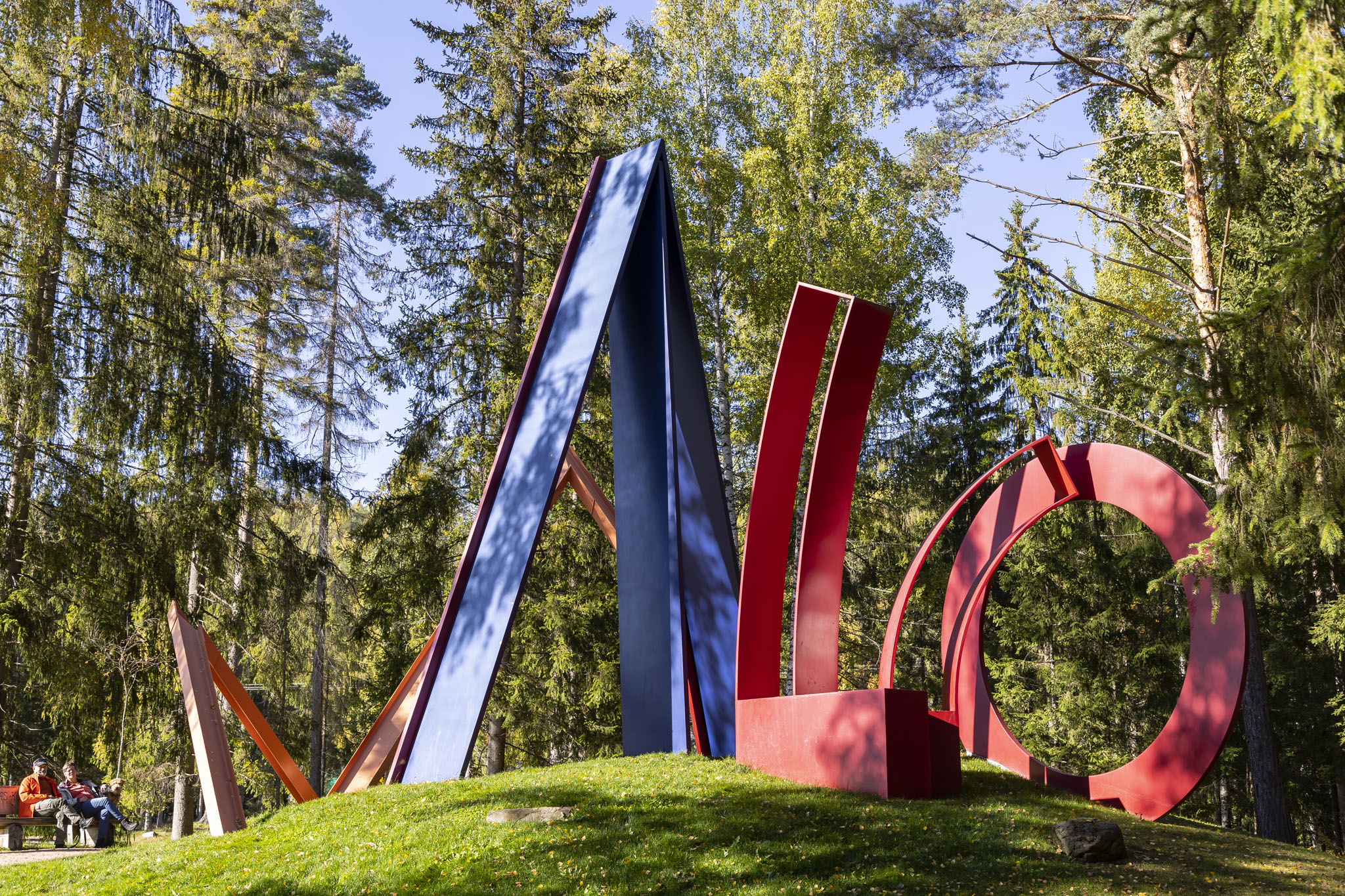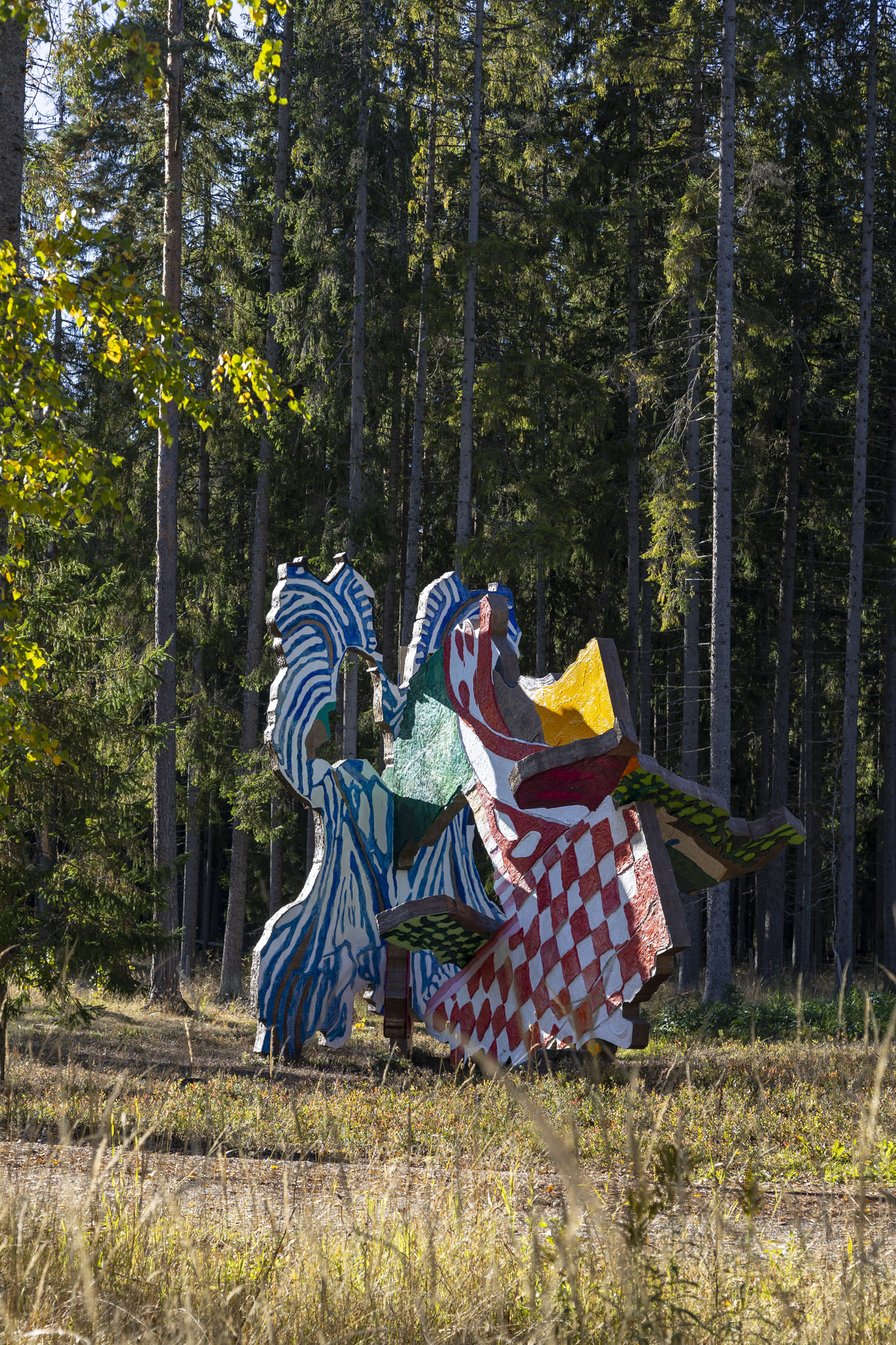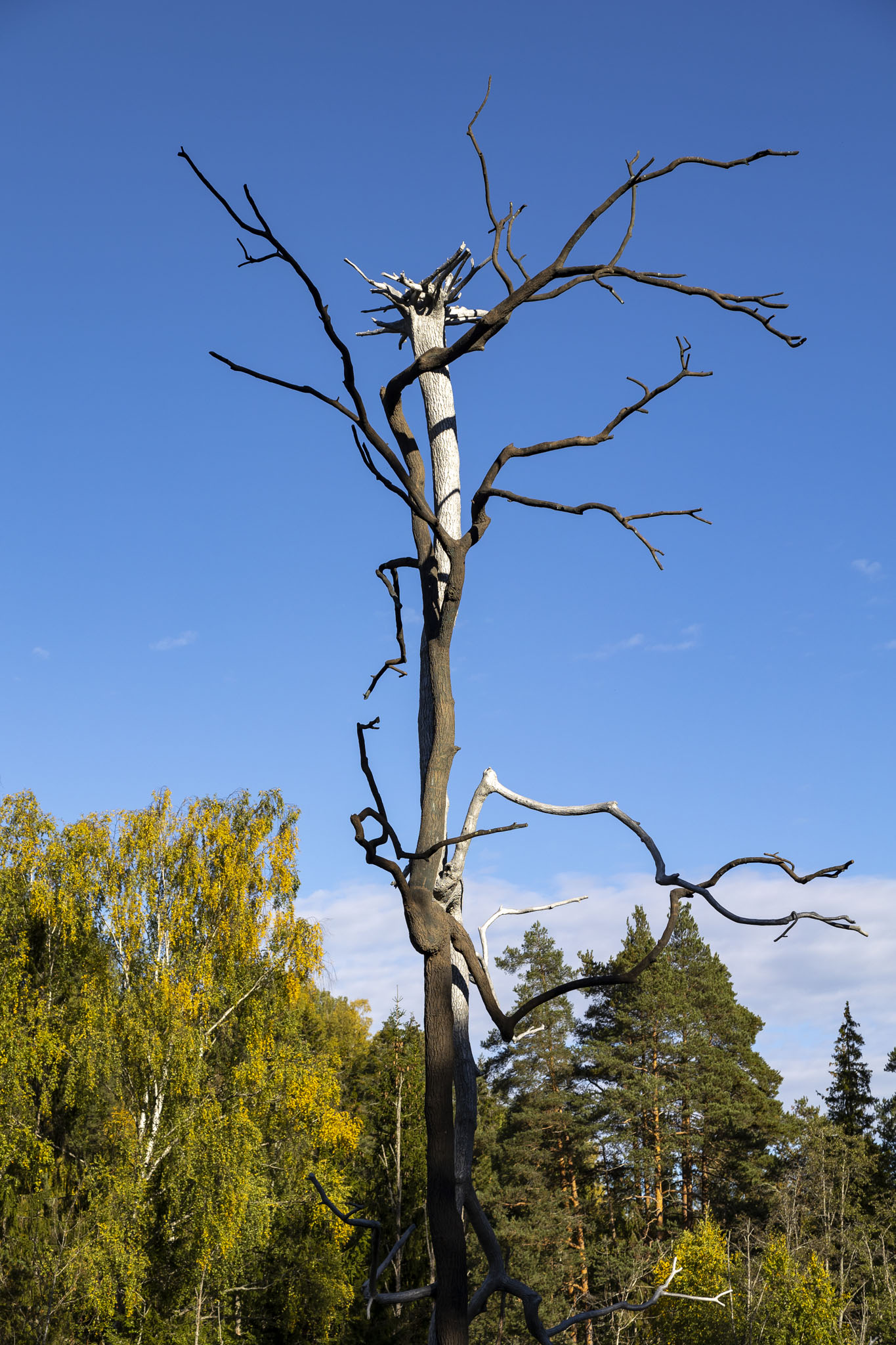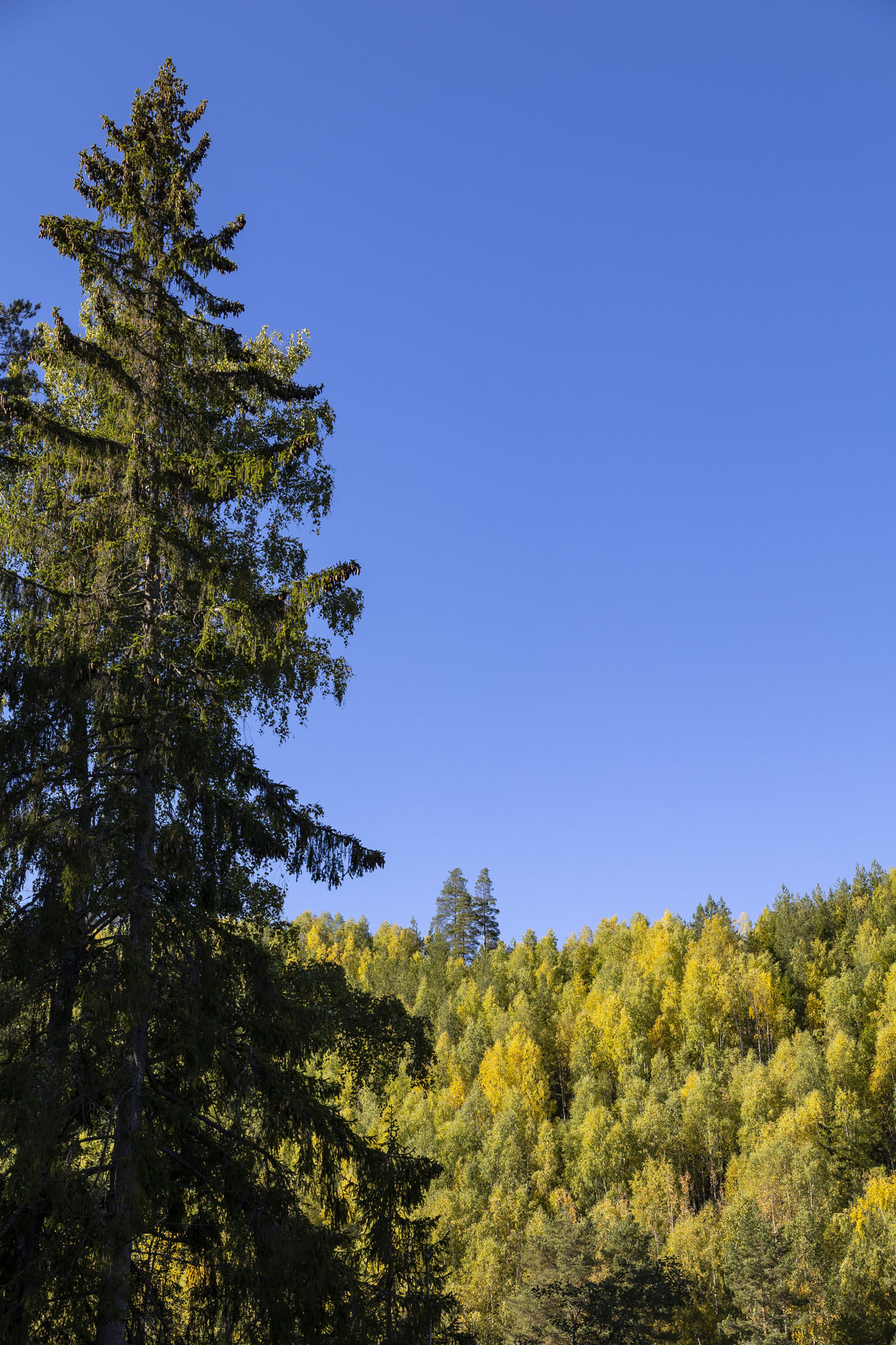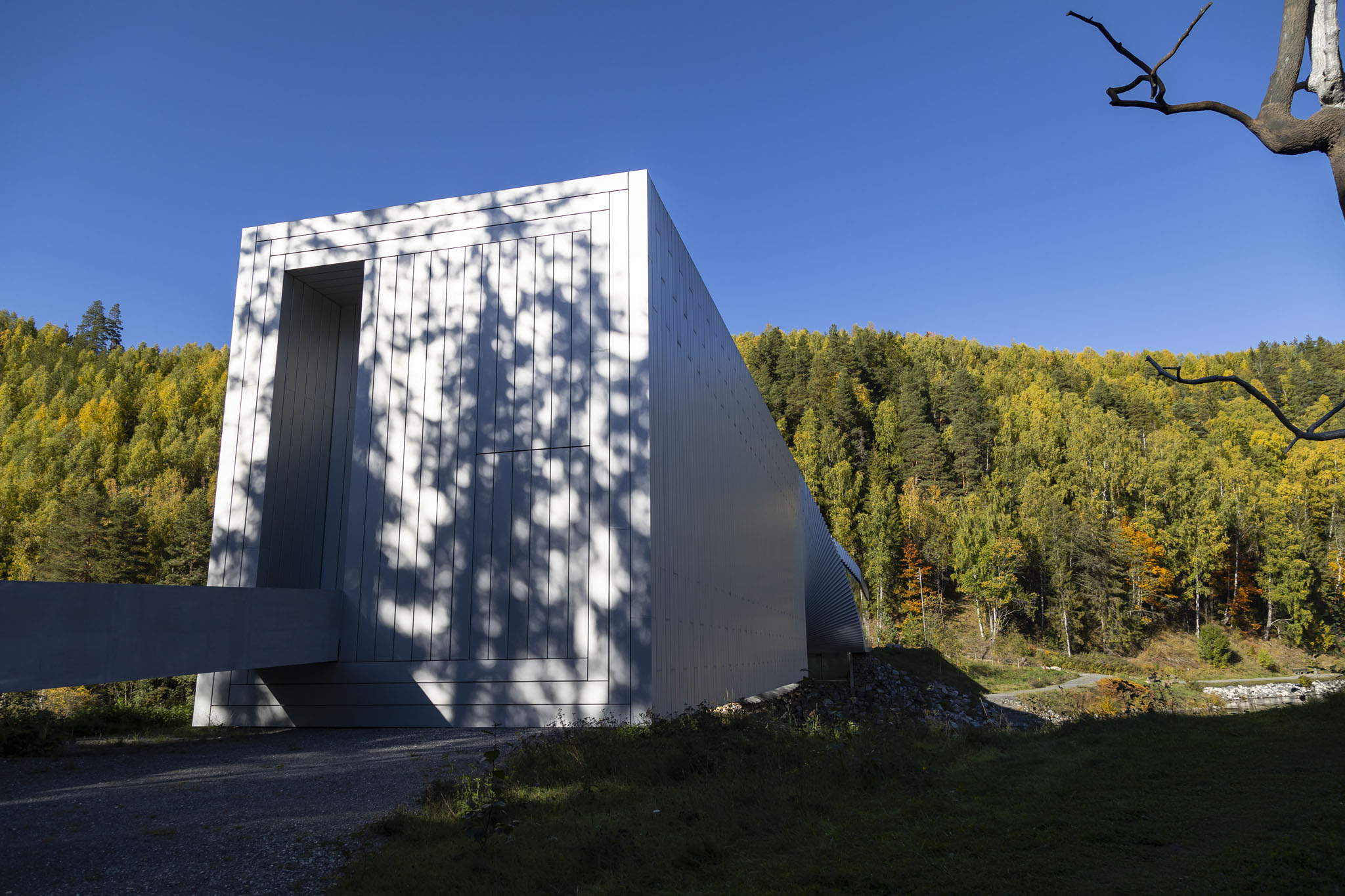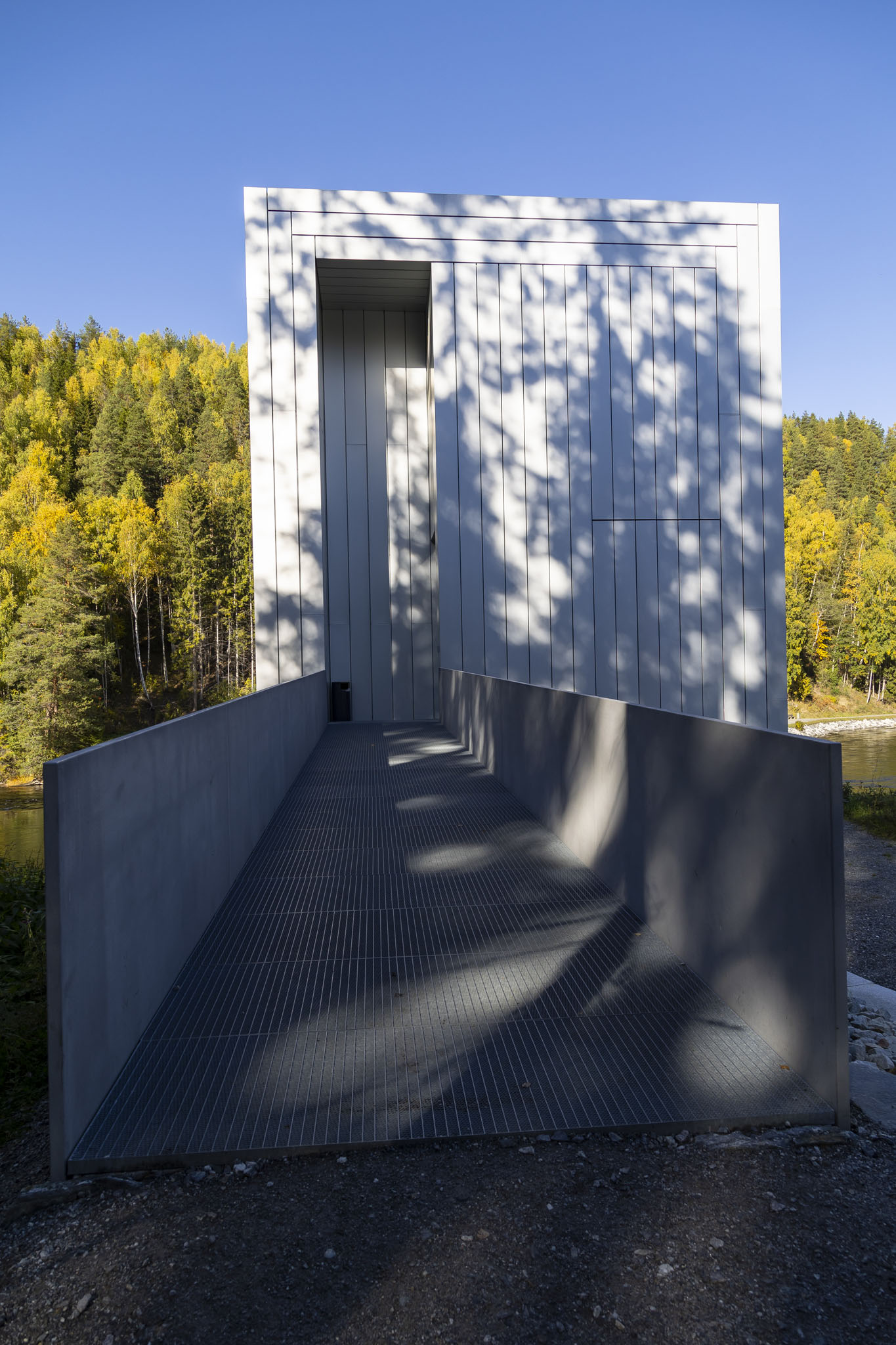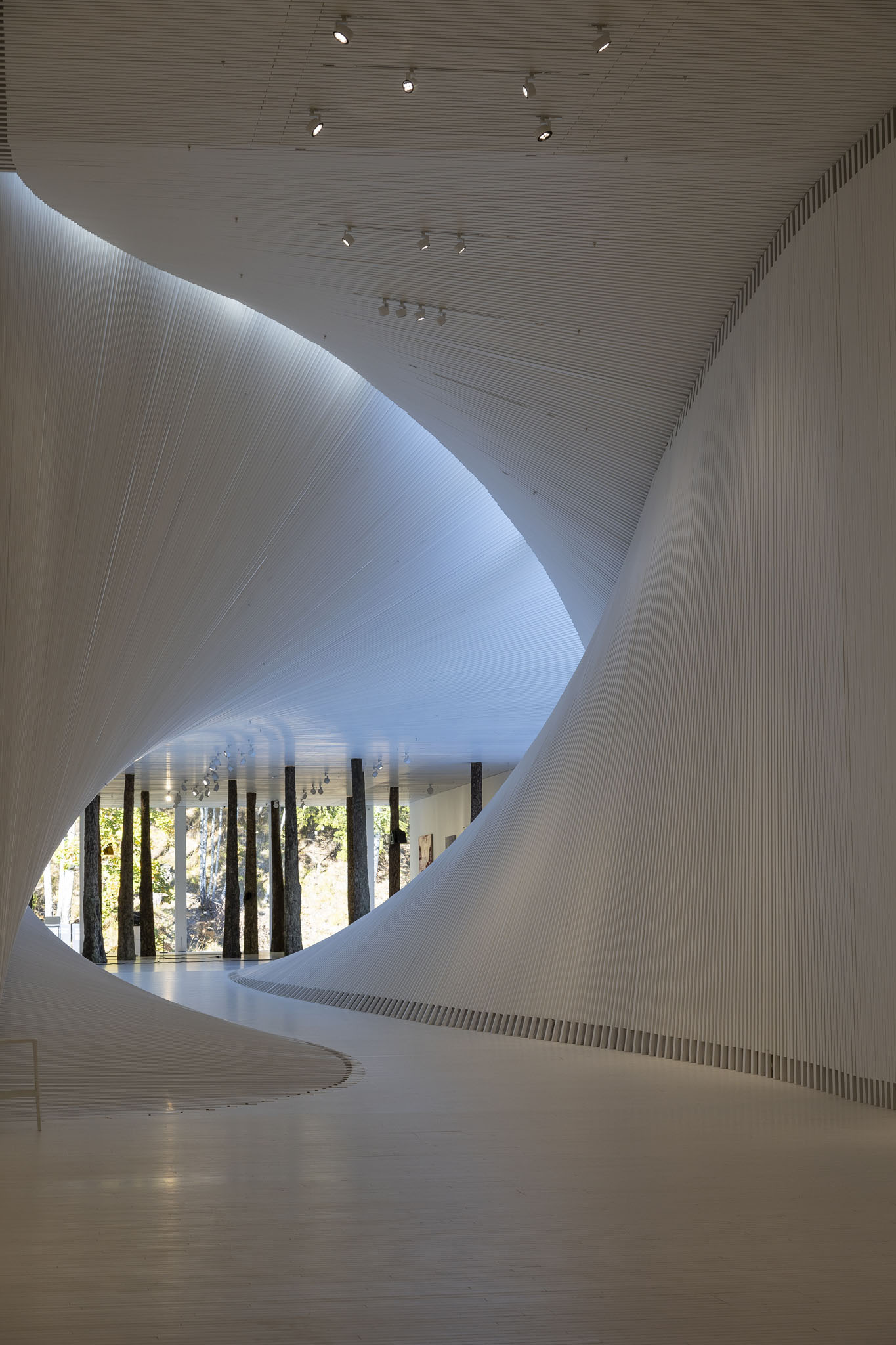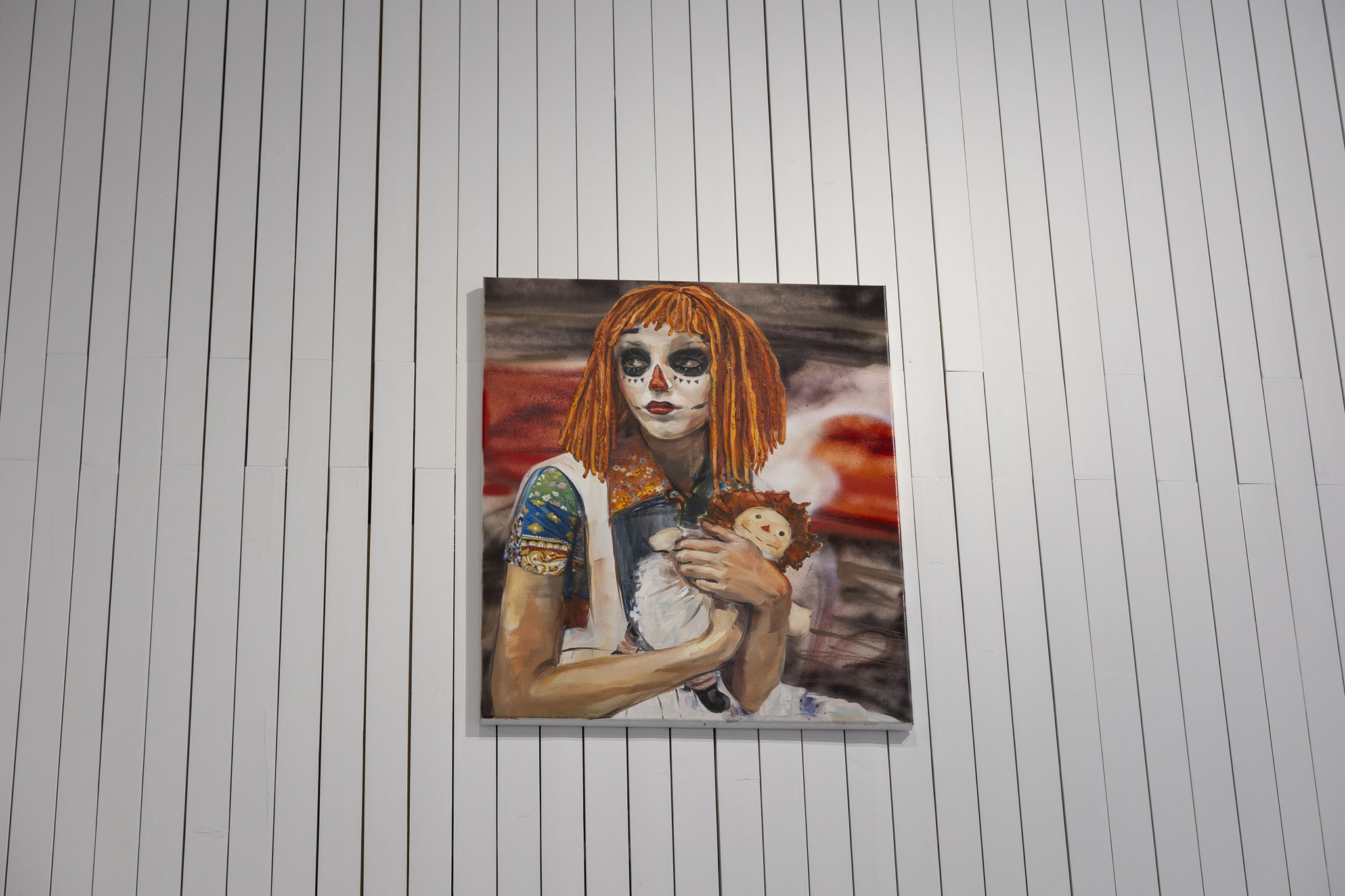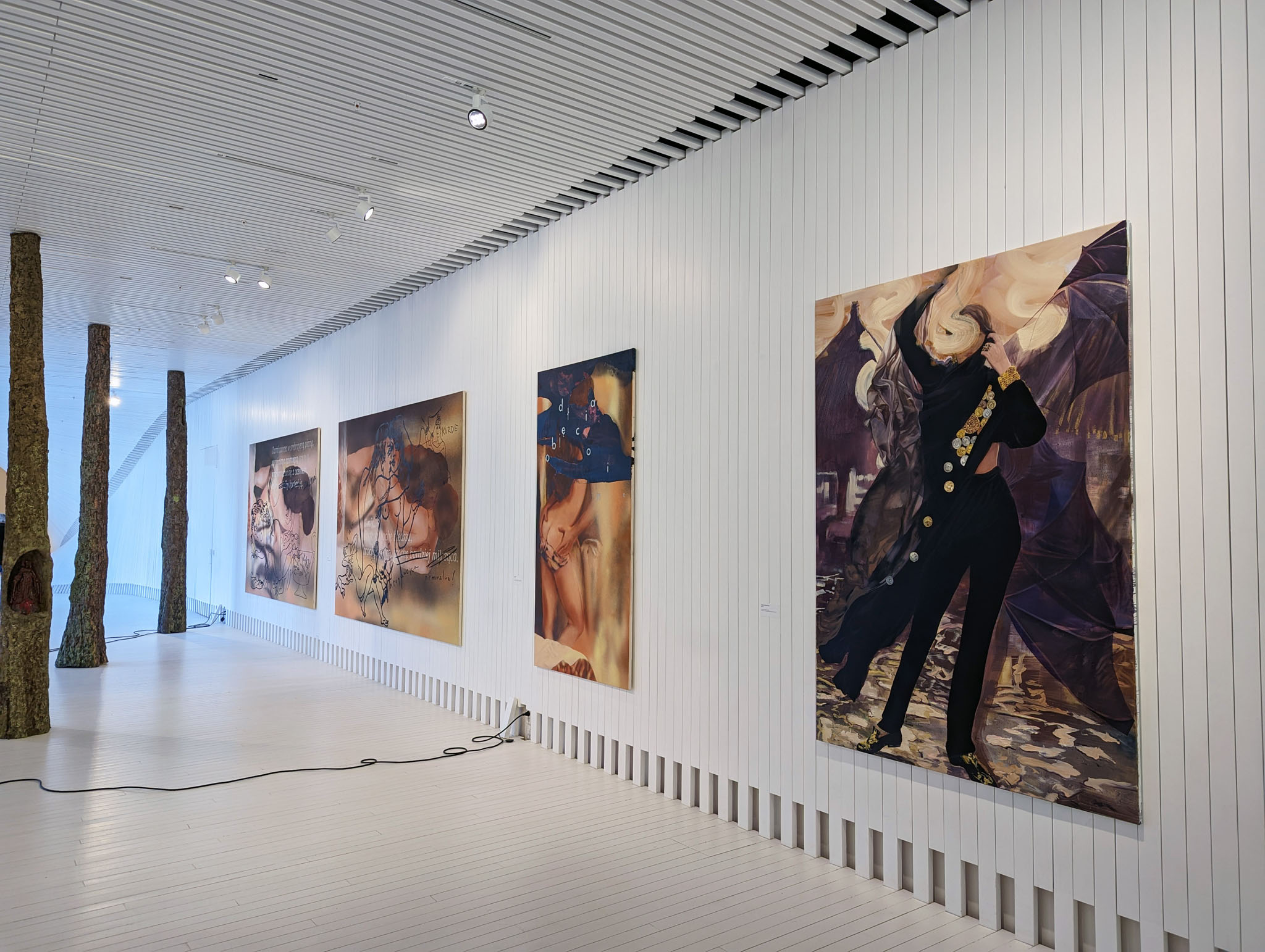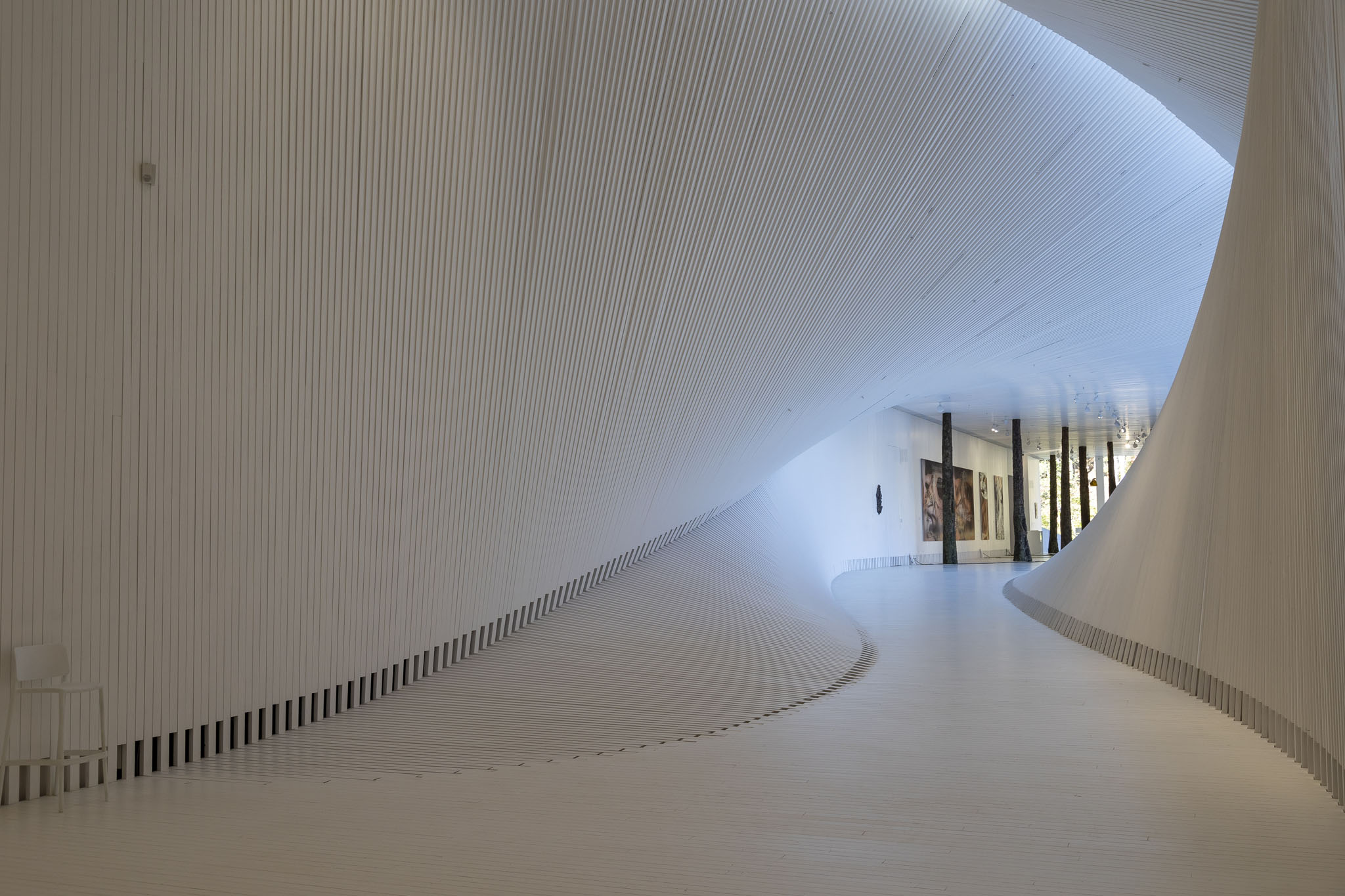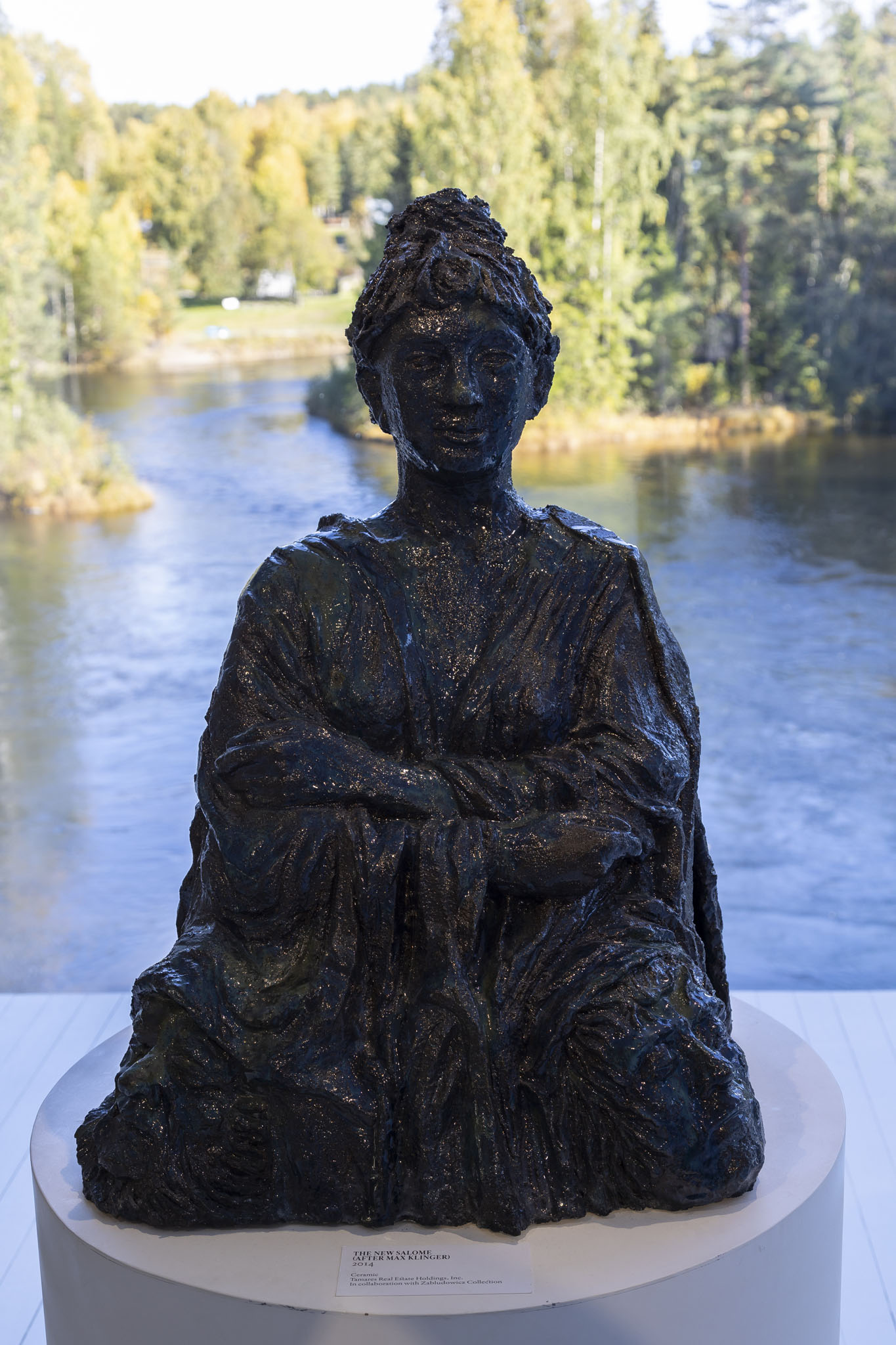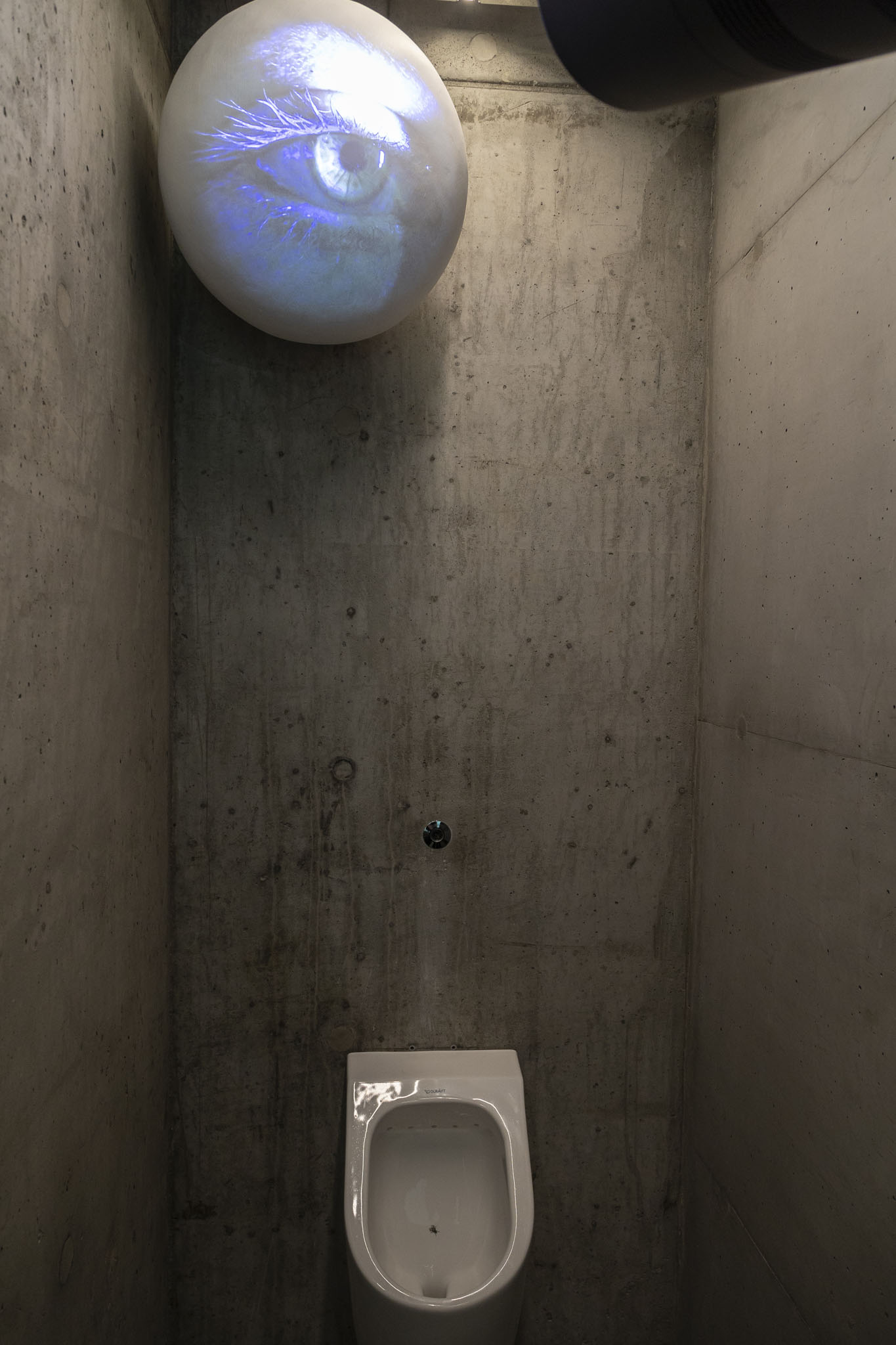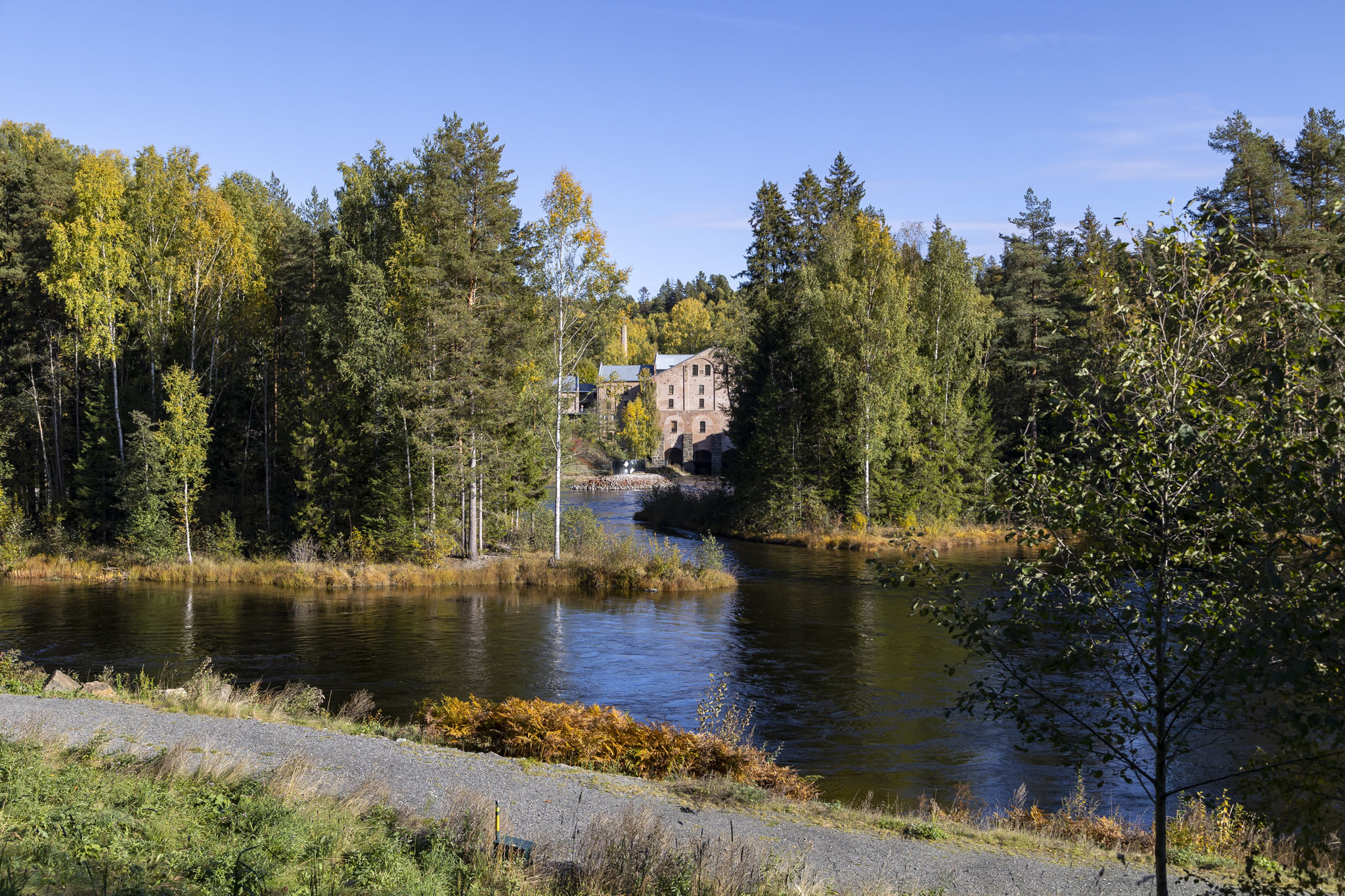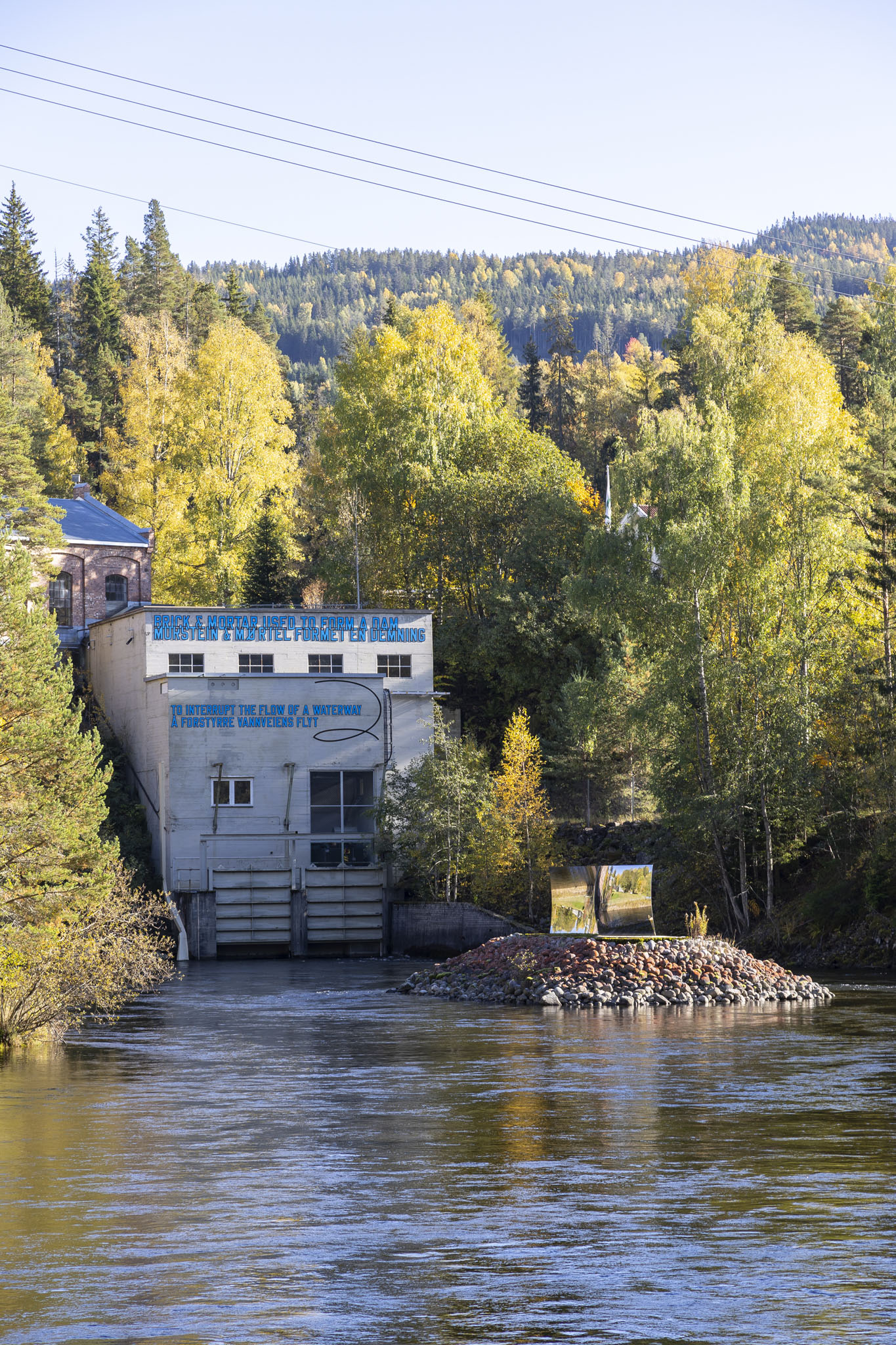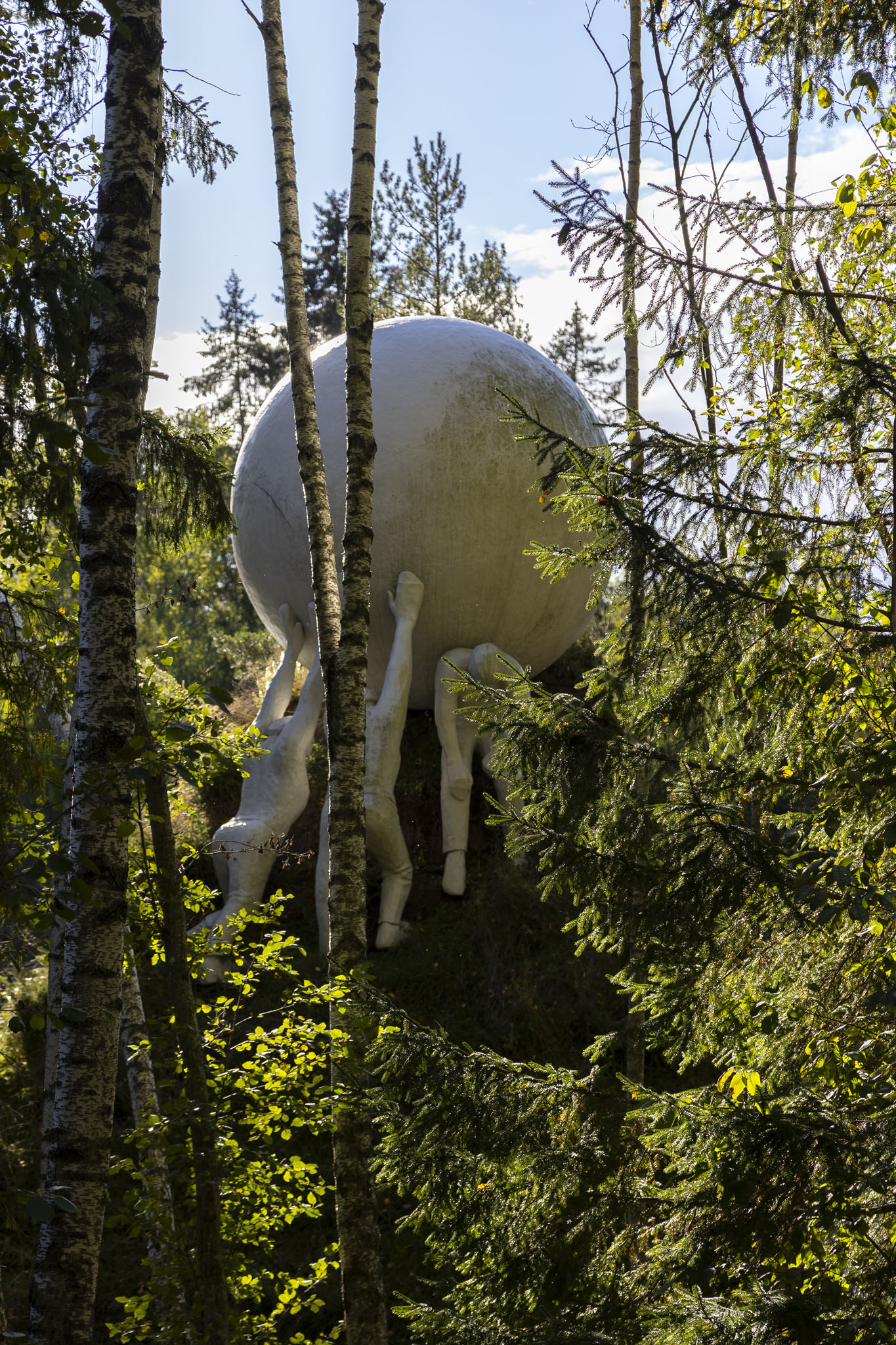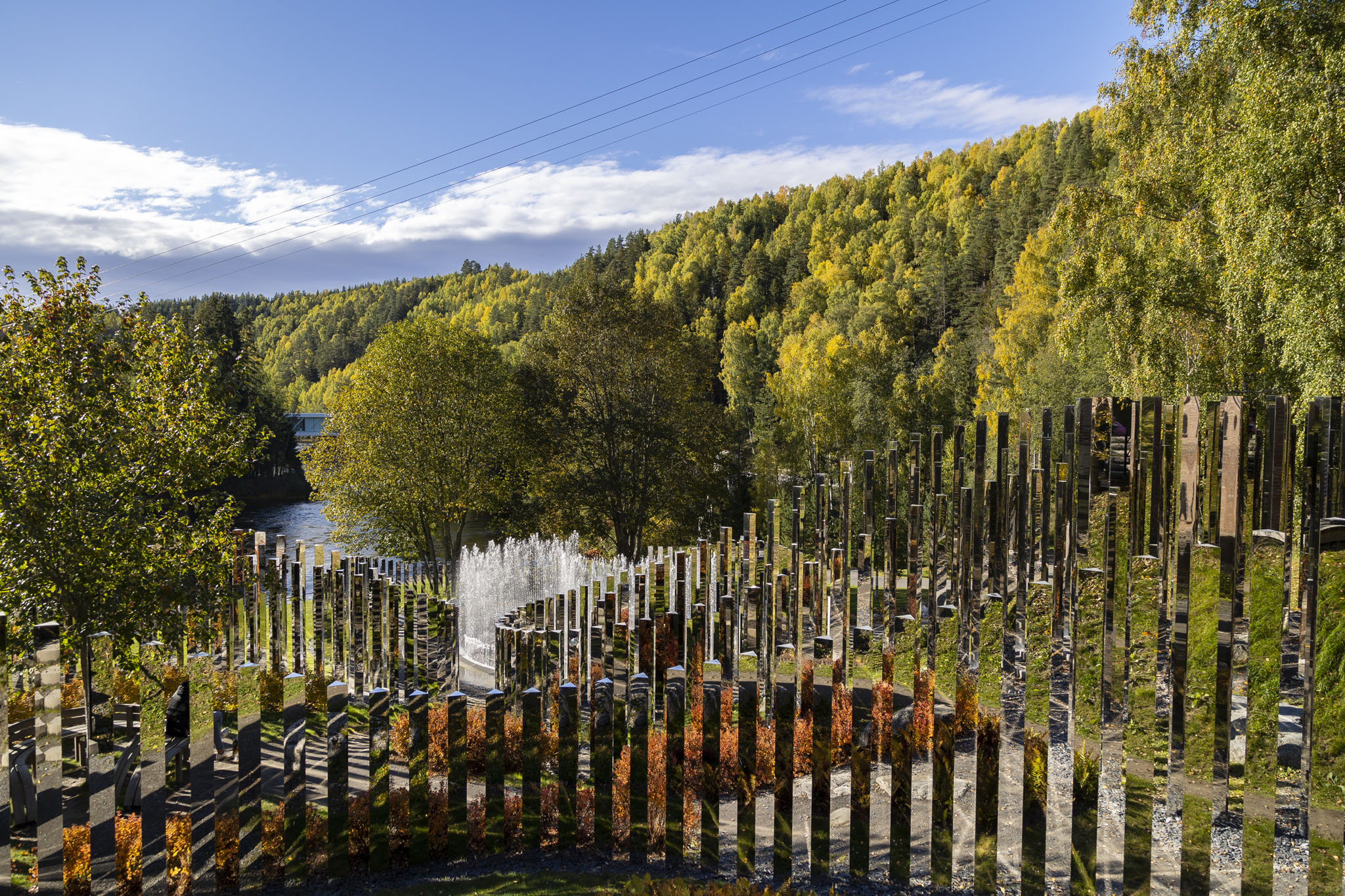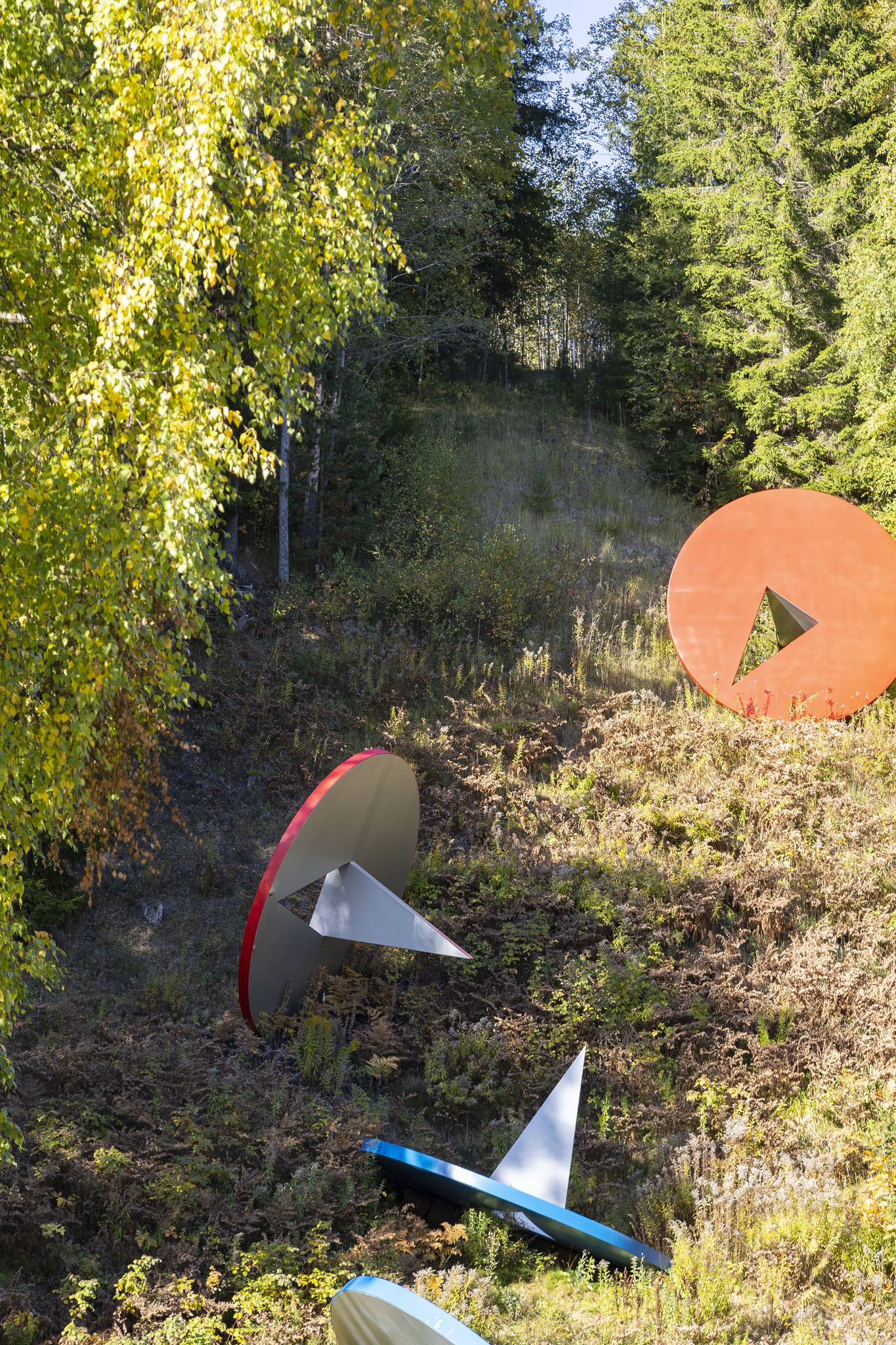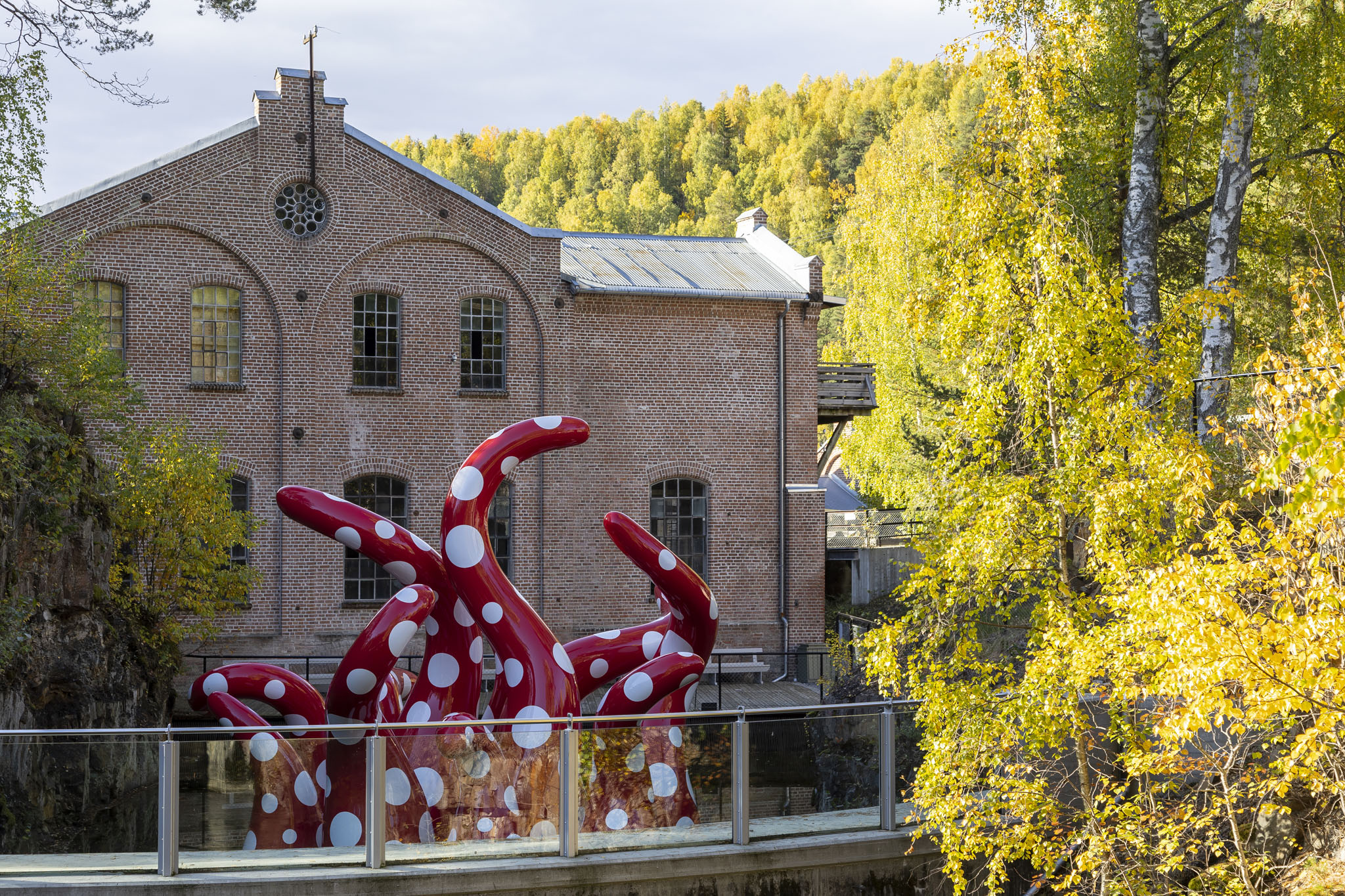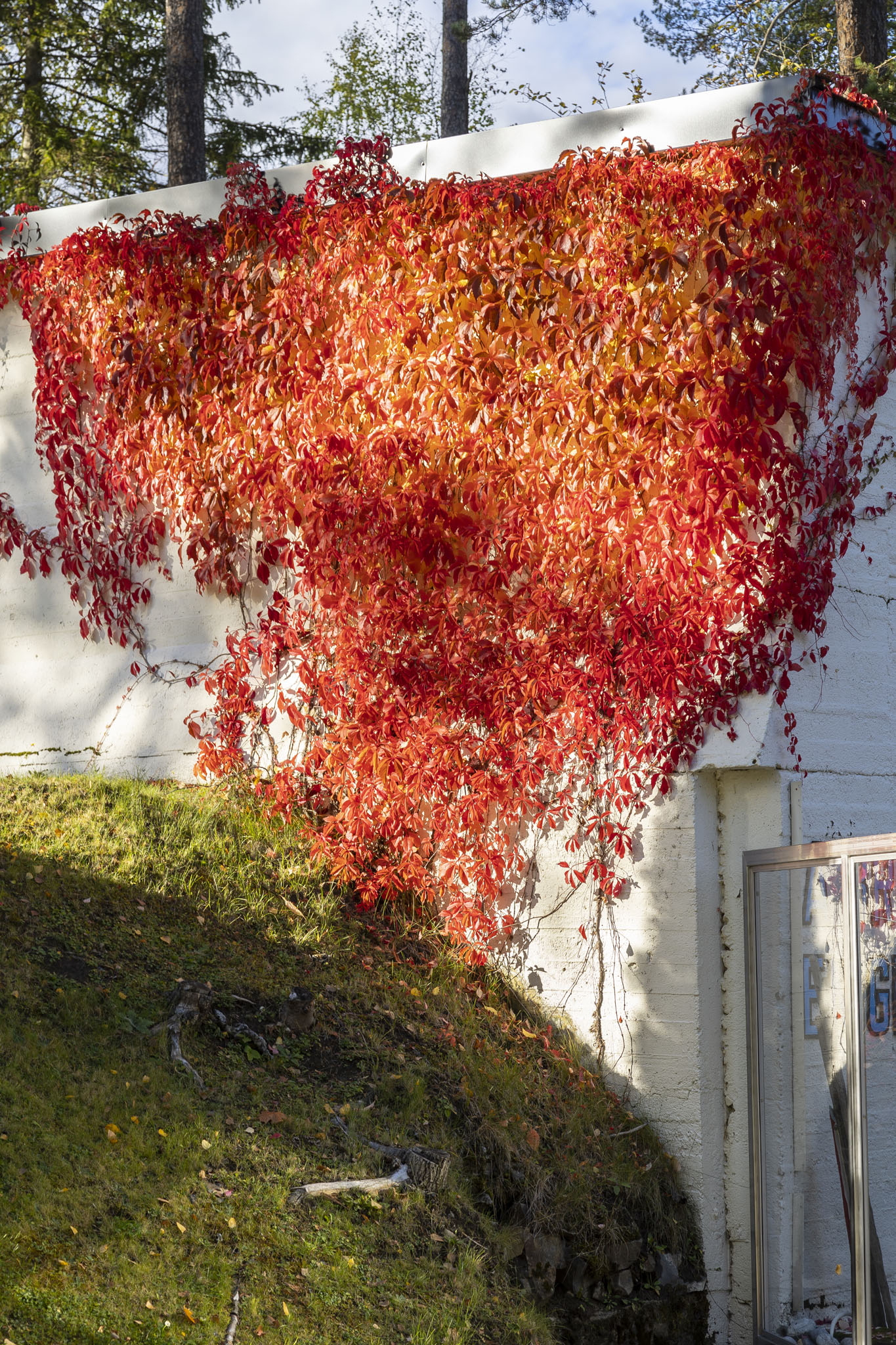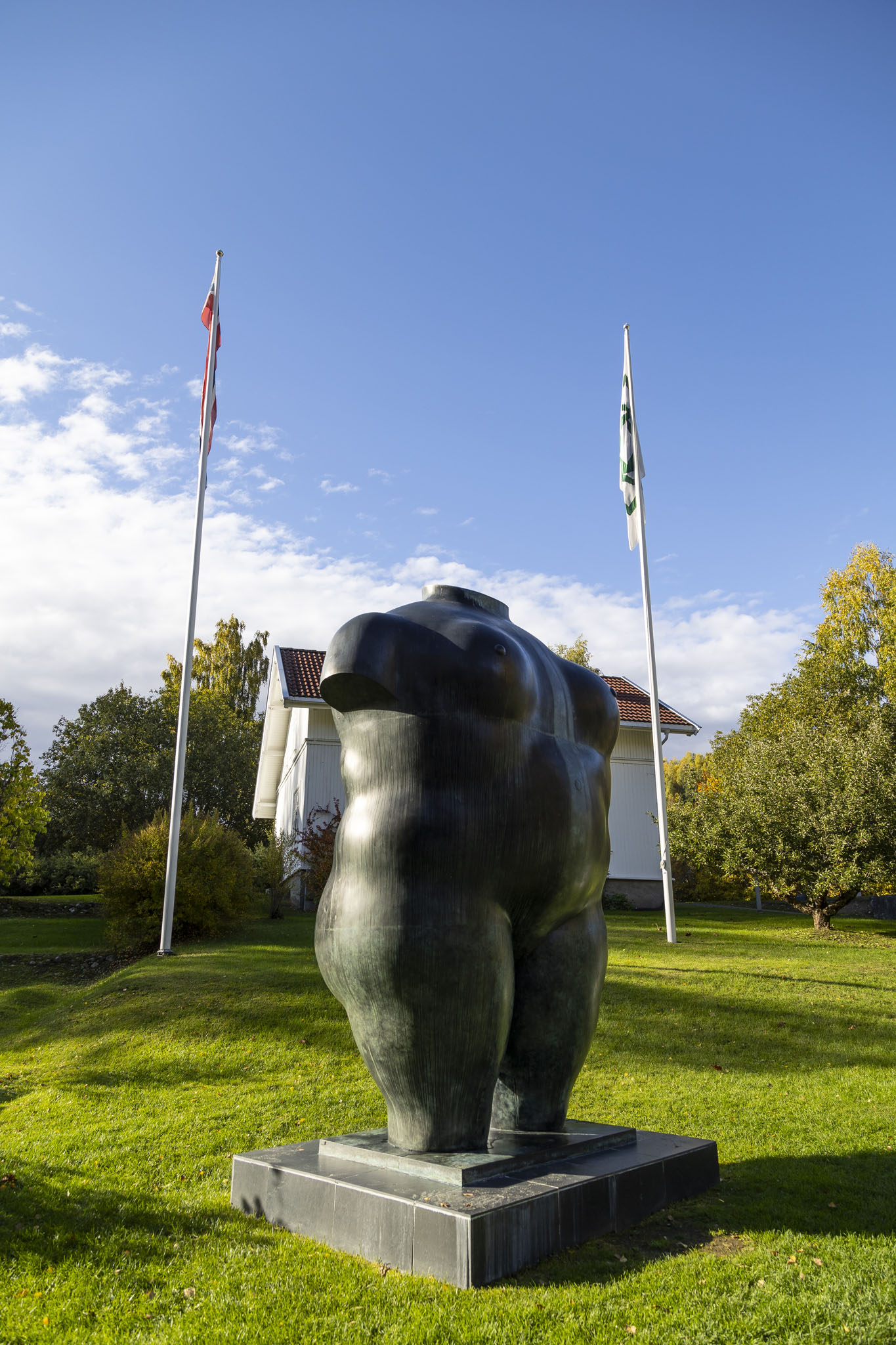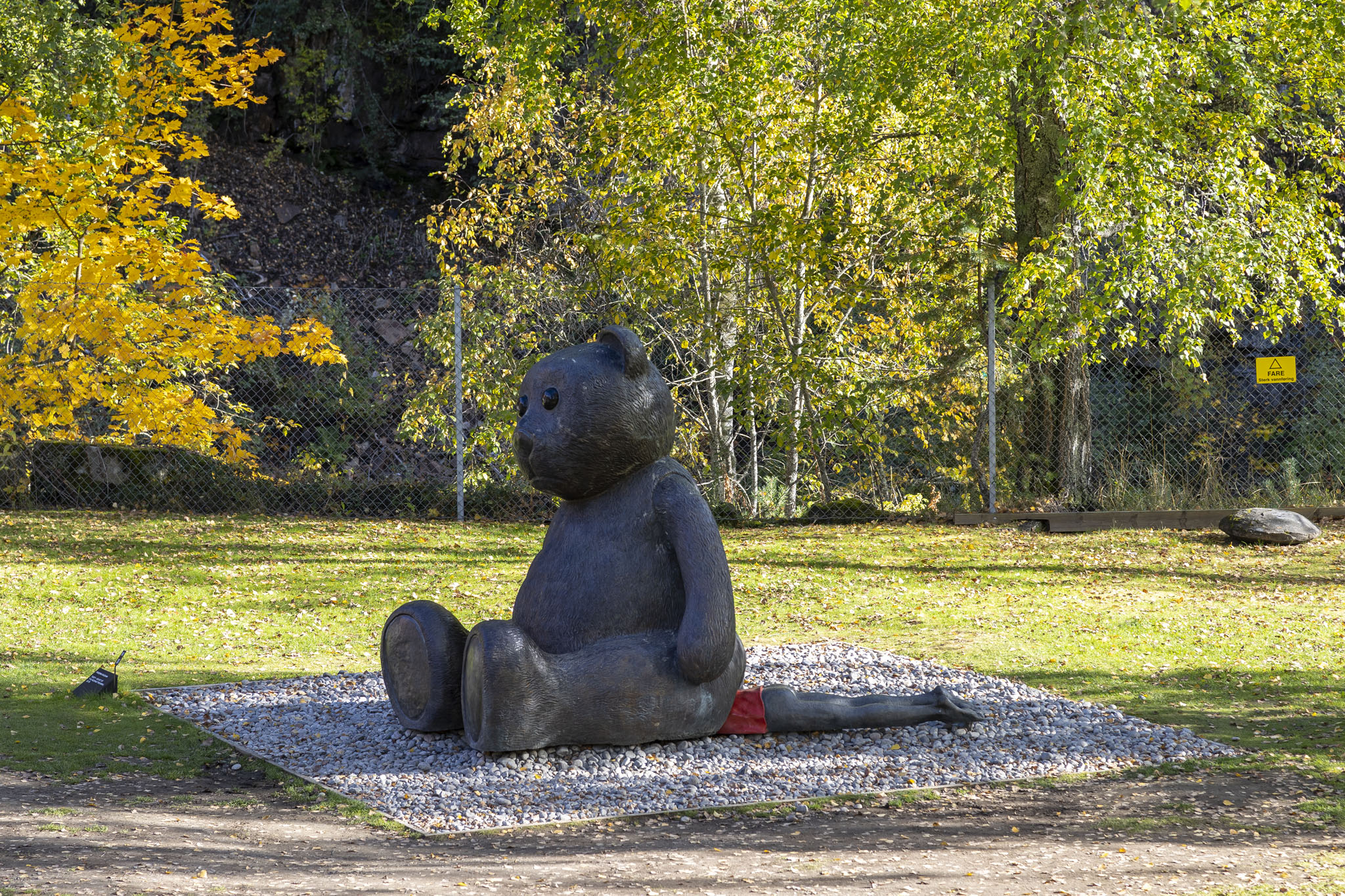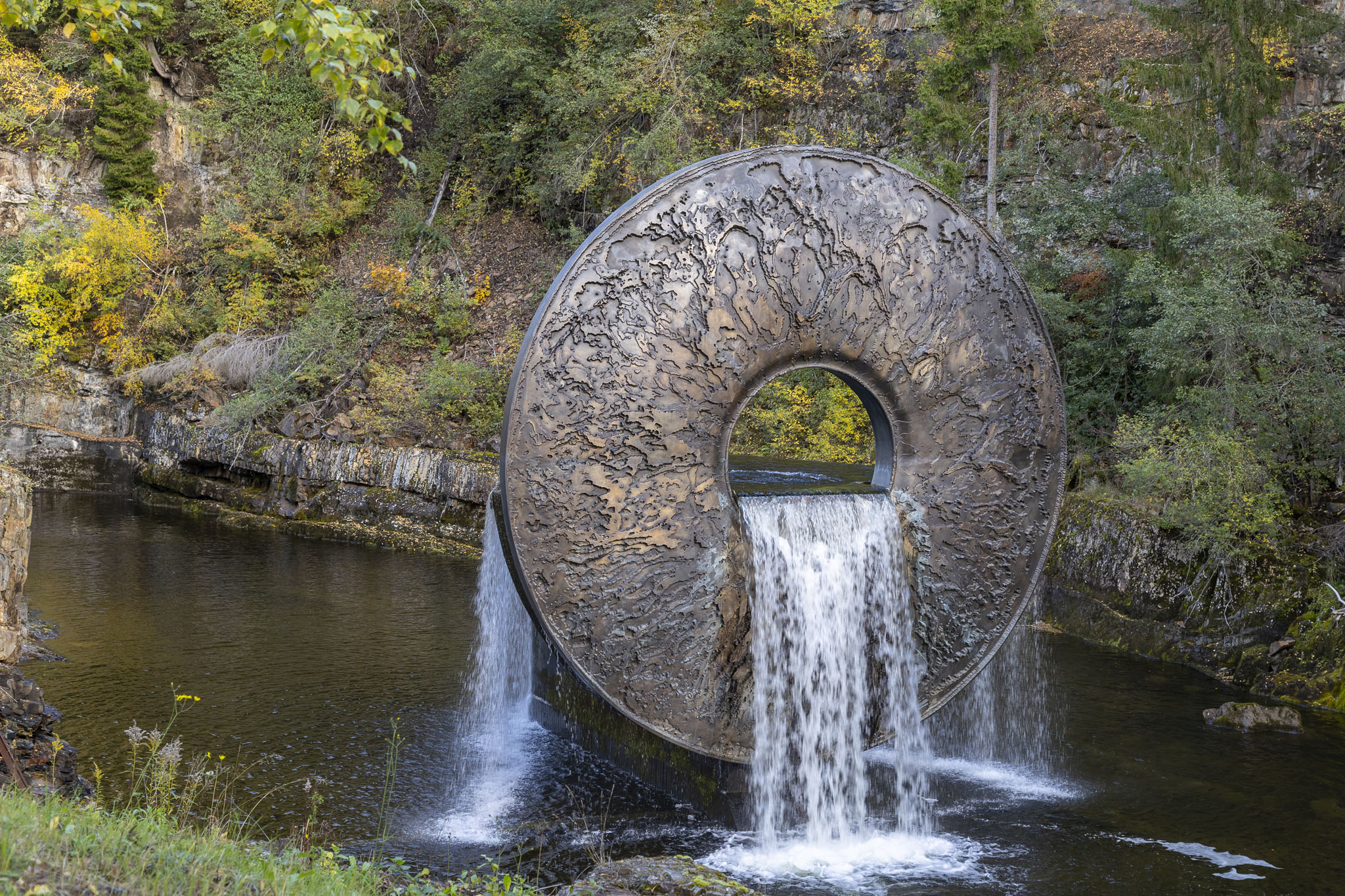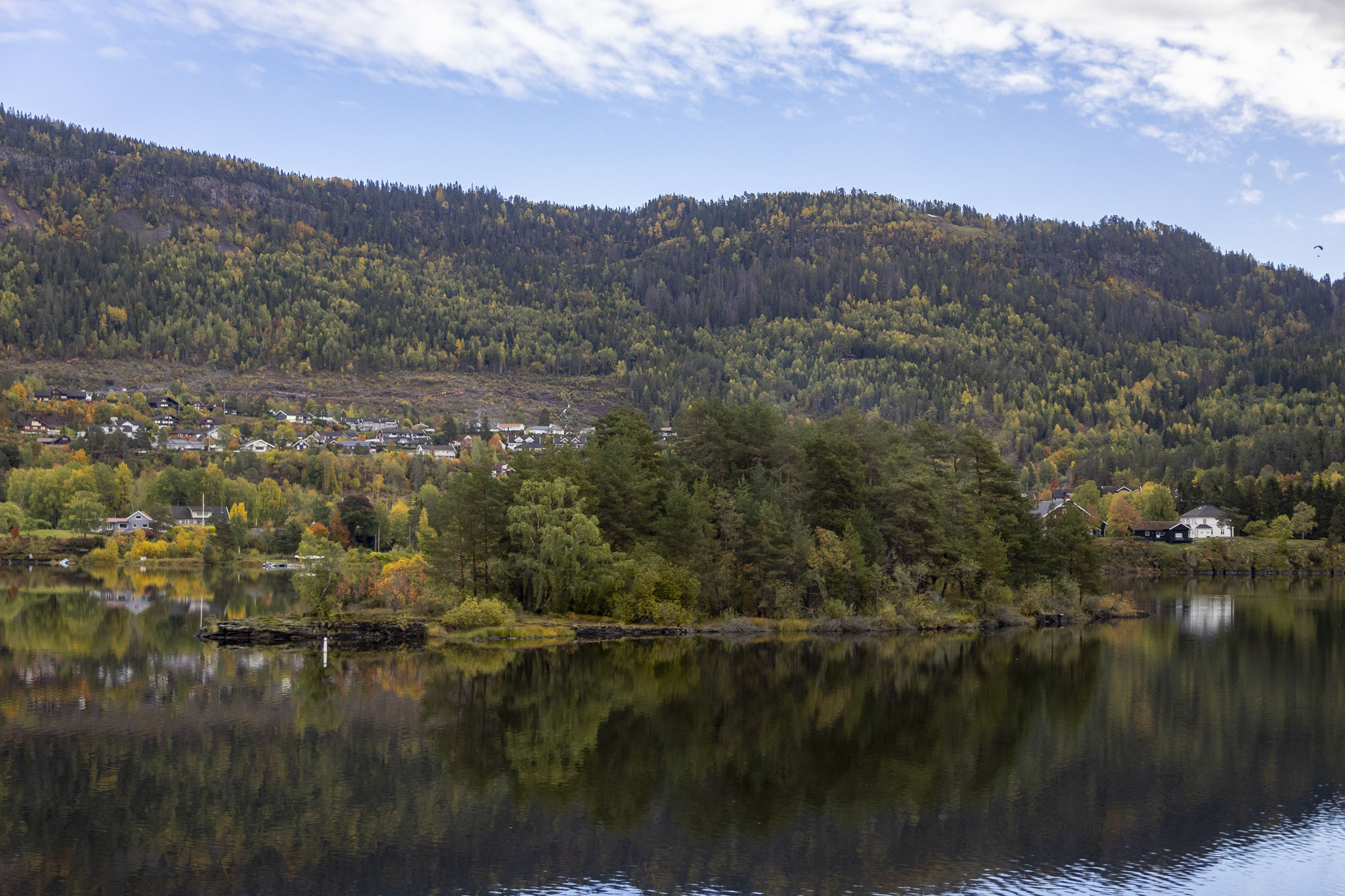For the second part of the day’s cruise excursion during Island Princess‘s port stop at Oslo on our 2022 Western Europe cruise we were driven a short way from where we’d seen glass blowing at Hadeland and arrived at Kistefos Museum.
Kistefos is a former wood pulp mill and hydroelectric power plant, making use of the waterfall on the river Randelva to generate power and to facilitate turning wood chips into pulp boards that could be transported and later processed further in paper mills. Within the area that constitutes Kistefos there are historical elements related to this former role which fulfil the museum aspect of the site, but for our tour to Kistefos we were concentrating on the modern art sculpture park and the world famous art gallery that can also be found there.
We had a great day weather-wise for our visit to Kistefos and we were immediately greeted by one of the pieces of art on display in the form of one of what would turn out to be a pair of male figures leaning in towards a structure. As much as possible, I’ve made a note of the name of the artwork and the sculptors responsible on the images themselves in this post so click on them if you need more information about any particular piece.
After a short walk through part of the large wooded area of Kistefos we came to its likely most famous artwork.
The Twist is an art gallery and a bridge and a work of art all in one. Opened in 2019 it has been nominated for awards numerous times and won the Leading Culture Destinations award for Architecture in 2020. The design of the building allows it to be supported by the banks of the river despite them being of different heights and incorporates different height spaces within its length to act as different gallery areas. Its entrance, admittedly, didn’t look like much.
We had to wait around outside the entrance to the Twist for a few minutes because we were visiting out of season. While the rest of Kistefos is open throughout the year – although some artworks are wrapped up to protect them from the elements when this happens – the Twist, because it houses art in the gallery, is open only when the main museum is open. As it also serves as a bridge this means that outside normal opening times there’s a slightly longer route around the park to take as another bridge is needed to cross the river further downstream.
Eventually, though, an employee came along to open up the Twist for us to look inside. A benefit of booking this trip to Kistefos on this cruise tour rather than trying to make it here ourselves was that the number of booked visitors could get us this special treatment.
Inside, the twist that gave the Twist its name became far more evident than it had been from the entrance we’d approached from. We’d get an even better view of the entire structure from the other side, and you can see that further down this post. We were guided through a number of installations inside the gallery space and had the artworks pointed out to us and described.
Let’s be clear here: if you don’t like modern art, whether the sort you hang on walls or the sort that’s sculpted, then Kistefos may not be for you. For us, we loved this. We won’t pretend to like everything or understand a tenth of what we often see but when it comes to art we simply hold to the old truth that we know what we like.
Even if you don’t like the art, the architecture of the Twist is absolutely fascinating.
We were told that there were toilets in the downstairs section of the Twist and we were encouraged to visit them. We didn’t need to use the toilets but we went anyway because we were also told that there were more artworks in that area. The projected facial parts over the urinals in the cubicles were delightfully eerie, and peering in from the river bank through the glass area on the lower part of the building was the second male figure artwork to go with the piece we’d seen at the park’s entrance.
At this point we should have left the Twist and headed back outside but this is when the site’s security system kicked in and suddenly our tour group, our guide, and the employee who’d opened it up for us found ourselves all trapped in an automatically locked-down art gallery. There are worse places to be trapped.
A call on the walkie-talkie and about fifteen minutes of waiting around was thankfully all that was needed for another employee to arrive and open up from the outside once more. We like to travel for the experiences and this certainly counts as one.
Back in the fresh air of Kistefos once more we started to walk around the water’s edge on the opposite bank to the one we’d entered the Twist from. Looking back we could see the proper shape of the building and its unique design, while ahead of us on the river we could see the old pulp mill ahead and some of the larger art sculptures on show.
One of the more visually-arresting sculptures on our walk around Kistefos was Path Of Silence by Jeppe Hein. Comprising four hundred and sixty stainless steel, triangular, mirrored steles arranged in a circular labyrinth and shaped with the contours of the land in mind to take the visitor through three quiet spaces: an inward-seeking space reflecting the views in and encouraging looking up; a natural space with a tree to connect the internal and external structures; a water space with a walls of water fountains making for ever-changing reflected views and the white noise cancelling out everything around.
Had we been visiting on our own then I’d have had to keep a close eye on my wife who has history when it comes to getting confused by mirrors in places. Luckily, with us being part of a tour group she could easily keep track of where she needed to walk, never once walked straight into her own reflection, and made it through the artwork and up to the higher level.
We’re both fond of cephalopods – we like smart creatures; even some humans – so Octopus by Bjarne Melgaard made us smile until I remarked that it looked like the terrifying Kinder Egg Humpty Dumpty character we used to see on TV had mated with Cthulhu. That’s an image that won’t leave the mind.
Energy-Matter-Space-Time by Petroc Sesti was a swirling vortex of mineral oil in a transparent container. It’s very clever in how it seemingly produces the vortex with no visible moving parts but I had to confess to being a little concerned that strong enough sunlight focussed through the artwork had the potential to set the surrounding area alight. Possibly an unfounded fear given the thickness of the construction material and liquid and focal length. Hopefully.
At this point we had almost completed a circle of what we had been taken to Kistefos to see on this tour and we were granted some lovely views back along the river towards the Twist once more.
The final sculpture we passed as we headed back to the bus was All of Nature Flows Through Us by Marc Quinn. This artwork is clearly based on an eye – not a doughnut – and the title more-or-less explains the meaning behind it with part of the river in the landscape cascading through the centre of it. It’s not just the light of our surroundings that comes in through the eye, but every part of what makes that up. We love being by the water in any form, and hearing it pour out and onto the river in this tranquil setting was just beautiful.
That brings the day’s excursion to an end in this part of Norway. There was plenty more in Kistefos to see that we didn’t get a chance to experience – the museum itself, more sculptures, more walking paths – but cruise tours are naturally limited in time. It’s certainly a place we’d not hesitate in returning to because it featured a lot of things we simply like to look at and visit when we travel.
In the next post in this cruise travelogue series I’ll cover some time on the top deck of Island Princess ahead of our cruise away from Oslo and a nice surprise in the evening.

